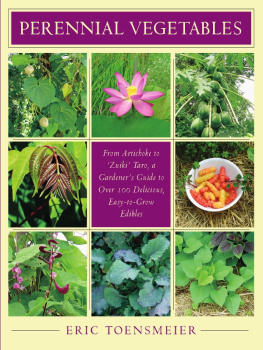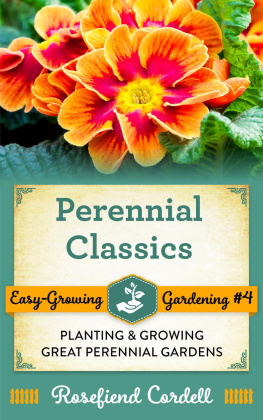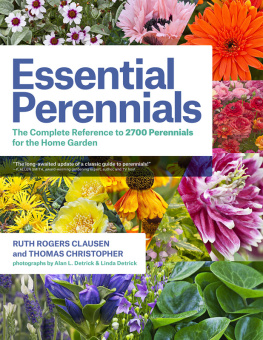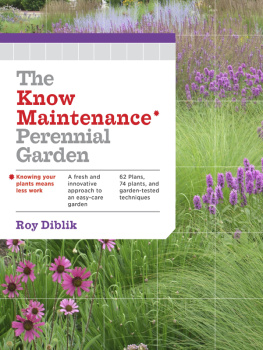

The Well-Tended Perennial Garden
PLANTING & PRUNING TECHNIQUES
Tracy DiSabato-Aust
EXPANDED EDITION
Timber Press

Page 1: a garden designed primarily for summer and autumn interest, Hendley garden, Ohio; pages 23: a mixed border designed to take advantage of effects of light, texture, and form, authors garden; pages 45: Geranium platypetalum, authors garden; page 6: Ricinus communis, Eupatorium maculatum Gateway, Echinacea purpurea, and Heliopsis helianthoides Sommersonne, authors garden; pages 1415: a shade garden with an emphasis on foliage, Heiberger garden, Ohio; pages 9697: informal repetition of hostas, astilbes, and daylilies, Blanchette garden, Massachusetts; pages 15657: Ligularia The Rocket, Rickli garden, Ontario; page 312: Papaver orientale Harvest Moon, authors garden; page 334: Eupatorium maculatum Gateway, Heliopsis helianthoides Sommersonne, Miscanthus sinensis Cosmopolitan, Echinacea purpurea, authors garden. All photos by author.
Copyright 2006 by Tracy DiSabato-Aust. All rights reserved. Black and white illustrations are by Beth Ann Daye.
Published in 2006 by
Timber Press, Inc.
The Haseltine Building
133 S.W. Second Avenue, Suite 450
Portland, Oregon 97204-3527, U.S.A.
www.timberpress.com
For contact information regarding editorial, marketing, sales, and distribution in the United Kingdom, see www.timberpress.co.uk.
Designed by Susan Applegate
Printed in Hong Kong
Library of Congress
Cataloging-in-Publication Data
DiSabato-Aust, Tracy.
The well-tended perennial garden: planting & pruning techniques/Tracy DiSabato-Aust.Expanded ed.
p. cm.
Includes bibliographical references and index.
ISBN-13: 978-0-88192-803-7
ISBN-10: 0-88192-803-8
1. Perennials. 2. PerennialsPruning. I. Title.
SB434.D37 2006
635.932dc22 2006010388
A catalog record for this book is also available from the British Library.
To
JIM & ZACHARY
For their love and support and for the magic they give to my life

CONTENTS
FOREWORD to the First Edition
THE POPULARITY of herbaceous perennial plants has fluctuated greatly over the last century in North America. Catalogs from the early 1900s illustrate the many perennials that were available during the period, but following the first quarter of the twentieth century the interest in perennials lessened. Until the early 1980s the use of perennials in North America was limited largely to estate gardens and to the highly interested home gardener. Woody plant materials and annuals or bedding plants were the talk of the trade, with a few perennials dotting the landscape.
In the early 1980s a reawakening occurred with a new awareness of herbaceous perennials by the gardening public. The Perennial Plant Association was formed in 1983, other area and regional associations concerned with perennials were formed, and symposium after symposium was offered on this new found palette of plant materials. In 1980 one could count the number of books about perennials on one hand. What a difference a few years can make! There are now dozens of books available on nearly any aspect of perennials. We can find books on individual species, design, color combinations, edible perennials, perennials in the fall, encyclopedic treatments of genera, and many others. Garden writers have recently asked: Is there any perennial topic that has not been covered? I can answer with a resounding Yes. One area where a complete coverage has not been made is that of maintenance and long-term care of perennials.
Fortunately, Tracy DiSabato-Aust has produced for gardenersand for professionalsan excellent horticultural account of the care and maintenance of perennials. The Well-Tended Perennial Garden provides a straightforward, no-holds-barred look at creating a perennial border or bed, from the beginning stage of soil preparation to planting, with specific pruning techniques to promote long bloom and long enjoyment of the garden.
The highlight of The Well-Tended Perennial Garden lies in the meticulous care taken to provide very specific information on perennial maintenance. Sections relating to maintenance in previous books on perennials too often are general in nature. Tracy has either experimented with each practice or has done a careful review and interviewed dozens of notable perennial experts to arrive at the specific suggestions that highlight this book. Practical applications obtained from over 20 years of work in Belgium, England, Canada, and Ohio have provided Tracy with many experiences to share with the reader. This book is destined to become the reference for home gardeners and professionals seeking answers for species-related maintenance questions.
The perennials industry has waited a long time for a work of high quality and accuracy on the subject of maintenance of perennials. Tracy DiSabato-Aust has provided this work with The Well-Tended Perennial Garden.
DR. STEVEN M. STILL
Department of Horticulture
The Ohio State University
PREFACE to the Expanded Edition
IT IS WITH great pleasure that we offer you this expanded edition of The Well-Tended Perennial Garden. We felt it was time to refresh some of the old photographs as well as add new photographs, particularly to the encyclopedia, and artistically provide the images throughout the book. We are also really excited to include journal entries at the back of the book for you to record your pruning and maintenance experiences from your own garden or from your clients gardens.
In the photographs in the main text, you will see some changes that have occurred to my gardens at Hiddenhaven since the appearance of the first edition in 1998. As is the case, Im sure, with your own gardens, there have been numerous additions and deletions, always with the hope of making the gardens better fit my dreams. And along with the blessings of a maturing garden (and gardener) comes a greater emphasis on changes that can reduce the amount of maintenance needed to keep the gardens looking good.
You will also see some new client gardens that further illustrate the points made in the chapters on the importance of sound horticultural techniques such as soil preparation, planting, and renovation of the garden, both for the home gardener as well as the professional gardener. I hope these before, during, and after images will be an inspiration.
One of the most rewarding aspects of this book for me has been that people actually use it. They will often come to me at a book signing with soil on the pages, tabs marking certain plants, and highlights and notes scribbled throughout. Professionals tell me that they keep it in their trucks for quick reference. Because of this, we wanted to provide a new section where gardeners can actually record the maintenance that they have done, particularly the pruning that they have performed on certain plants. The journal is set up to reflect the way that I did the evaluative research for this book, and includes entries for the date of pruning, the height of the plant before pruning, the amount of material that was removed, as well as follow-up information such as the delay in flowering or height reduction for pruned plants compared to unpruned plants. You can also indicate when you staked a planthopefully at the right time! Notes on feeding, pests, or division can also be recorded. And in the general comments section, you can list observations that normally get forgotten by the time youre in another gardening season and trying to remember what you did in the past that did or didnt work. Have fun with this; I look forward to seeing your notes sometime.
Next page










